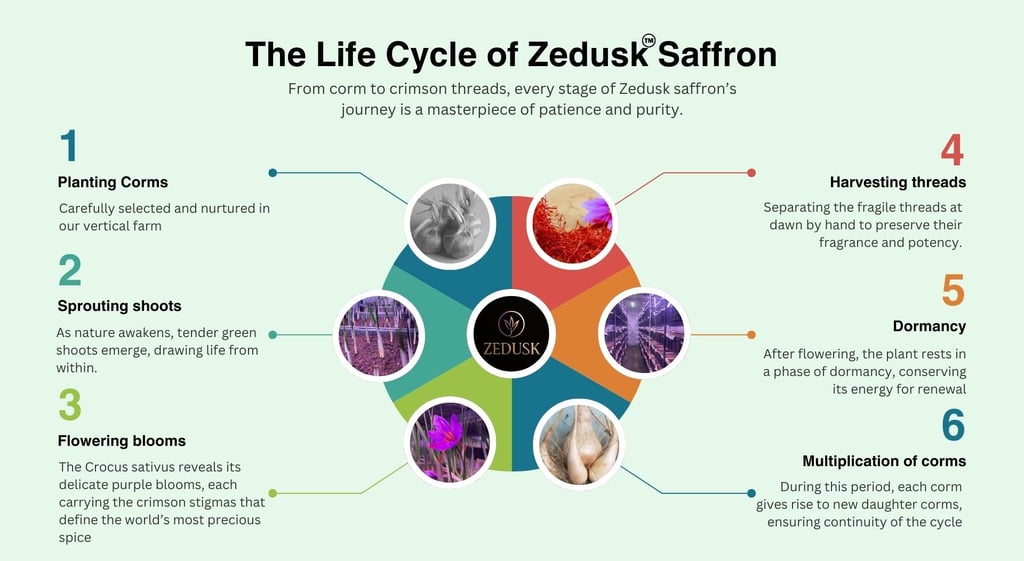Vertical Saffron Farming
What it is
Vertical saffron farming grows Crocus sativus indoors on stacked racks under LED lighting with tight control of temperature, humidity, and irrigation. Instead of relying on weather, growers follow a forcing schedule to trigger flowering on cue, then finish vegetative growth under optimized light so corms recharge for the next cycle.
Why it matters
Resource efficiency. Modern hydroponic/indoor systems can reduce water use dramatically versus open fields thanks to recirculation and water recovery—reviews commonly report up to ~90%+ savings (system- and crop-dependent). (PMCMaximun Academic PressScienceDirect)
Consistent, clean production. Indoors you can avoid many field pests and meet clean-label expectations with minimal or no pesticides. (Oxford Academic)
Climate resilience. By decoupling from heat waves and erratic rainfall, indoor saffron stabilizes yield and quality. (PMC)
How it works (the crop cycle)
Corm selection & warm storage
Big, healthy corms flower more. Warm, dry storage around 23–27 °C for >50 days (but <150 days) induces flower initiation before cool forcing. (Doc Développement DurablePMCBioOne)Flower forcing
Shift to cooler conditions (≈15–20 °C) to open blossoms over ~2–3 weeks; keep humidity/airflow tight to protect flowers. (ResearchGate)Vegetative recharge
After harvest, leaves photosynthesize to rebuild corm reserves. Light spectrum and DLI (daily light integral) measurably influence growth and flowering. (NaturePMCBioMed Central)Post-harvest & quality
Stigmas are gently dried to lock aroma (safranal) and color (crocin), then sealed and graded under ISO 3632 parameters. (ScienceDirectPMC)


Why saffron fits vertical farms
High value, low biomass. Saffron’s value per gram and small plant size suit controlled environments; soilless/CEA trials and reviews show viable yields with tuned fertigation and density. (MDPITaylor & Francis Online)
Programmable flowering. Temperature-driven dormancy/forcing lets you plan labor and sales windows precisely. (Doc Développement Durable)
Infrastructure at a glance
Racks & trays: Multilevel shelves designed for airflow and sanitation.
LEDs: Tunable blue/red mixes and adequate DLI for both flowering and leaf phases. (NatureMDPI)
Climate control: Tight temperature bands for storage/forcing and robust dehumidification/filtration. (ResearchGate)
Irrigation: Recirculating hydroponics or inert substrates with precise fertigation. (Plant Archives)
QC lab & packaging: Moisture tests, spectrophotometry, and light-safe sealed packs; follow ISO 3632 analytics. (PMC)
Challenges (and playbooks)
Energy & heat loads
Cooling during forcing, dehumidification, and lighting are the main OPEX drivers; design for efficiency and heat recovery. (ScienceDirect)
Labor peaks
Bloom windows are short and highly manual; plan staffing and workflow around forced flowering waves. (PMC)
Corm strategy
Corm size, health, and replacement cycles drive flower count and future daughter-corm yield—larger mother corms generally produce more flowers. (ScienceDirectISHS)
Plant health & diseases (critical in vertical saffron)
Corm-borne rots (especially Fusarium oxysporum)
Widely reported as the most destructive saffron disease; recent work from Kashmir characterized aggressive races. Importantly, mechanical injury strongly predisposes corms to rot, so gentle handling and clean cuts matter. (PubMedPMCFrontiers)Actions: quarantine new lots; sort and reject suspect corms; sanitize tools and benches; maintain dry, well-ventilated conditions in storage/forcing. Comprehensive reviews outline IPM options. (MDPI)
Viruses (e.g., CMV, SaLV) impacting quality
Surveys show latent/mixed infections; Food Chemistry data indicate virus presence can modify key metabolites (crocin, picrocrocin, safranal) and thus quality grades. Use clean stock and exclude vectors even indoors. (PubMedMDPI)Nematodes
Field surveys (e.g., Morocco) report Ditylenchus, Pratylenchus, Helicotylenchus associated with saffron; corm-borne hitchhiking is the risk for indoor farms. (ScienceDirect+1)
Disease-management playbook for vertical rooms
Inbound quarantine & testing – Hold each lot; sample-test for Fusarium and viruses before racks. (MDPI)
Pre-plant sanitation – Validated protocols include thiabendazole dips before sowing/storage (confirm local regulations); some programs also use carbendazim/mancozeb in field contexts. (ejfa.pensoft.netMDPI)
Injury minimization – Sort/plant gently; injury is a major trigger for corm rot outbreaks. (Frontiers)
Biocontrol integration – Trichoderma/Bacillus strains have shown suppression of Fusarium and reduced propagules in saffron trials; build them into an IPM stack. (MDPIPMC)
Room hygiene & RH control – Sanitize tools/surfaces; manage condensation and petal wetness during forcing and curing. (Best practice echoed across CEA literature.)
Ongoing monitoring – Weekly checks of corm bases/crowns; remove suspects fast; periodically verify via lab tests alongside ISO 3632 quality grading. (PMC)

